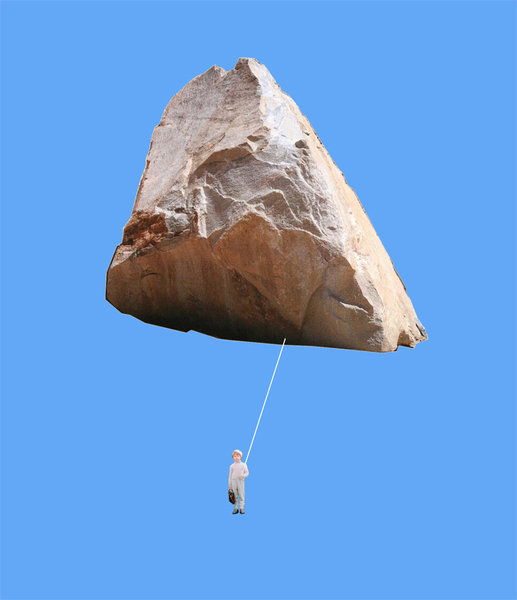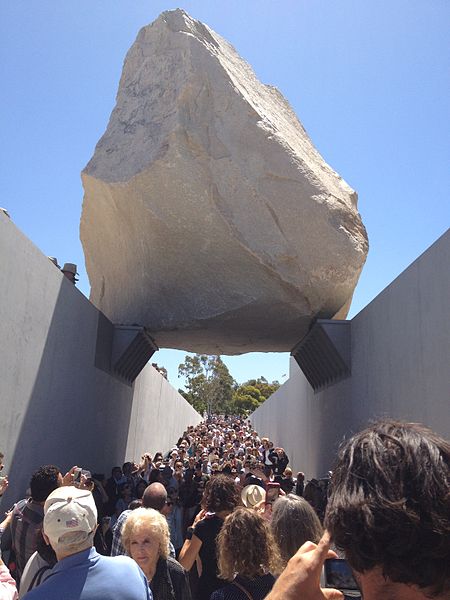Levitated Mass by Michael Heizer via Wikipedia
[Nature abhors a vacuum, your bifurcated blogger abhors an absolute. Be advised that I patrol both sides of the street in this post.]
Call it Colossus of Rhodes Syndrome, that tic of contemporary art that assumes if it’s BIG enough it MUST be good. So a 340-ton boulder was brought to the Los Angeles County Museum of Art campus and installed as a phenom: Levitated Mass by Michael Heizer.
For comparison, I read that the average size of an Egyptian pyramid stone is about 2.5 tons — the outer stones at Stonehenge are 20 to 30 tons. These latter were brought 160 miles from Wales. Heizer’s stone started 60 miles away but traveled 107 miles along a route requiring the travail of many. Make way, make way! Cinema has imagined for us the straining lines of slaves that towed the massive pyramid stones. Heizer’s pre-levitated mass moved on a custom-made transporter with 196 wheels.
In honor of the many theories that have been attached to the pyramids I will note that 196 divided by 4 is 49, which is the square of 7. And 7 is a prime number. Surely there’s a theory about contemporary consciousness to be discovered here.
The museum says that Levitated Mass
…is composed of a 456-foot-long slot constructed on LACMA’s campus, over which is placed a 340-ton granite megalith. The slot gradually descends to fifteen feet in depth, running underneath the boulder. As with other works by the artist, such as Double Negative (1969), the monumental negative form is key to the experience of the artwork.
I wonder about any artwork (visual, musical, literary…), that can’t be appreciated on its own merits. Yes, reading Ulysses with the right scholar’s guidance* will enhance your understanding of the book, but Ulysses is a multifarious, multi-layered, specifics-laced compendium that is also a work of artistic genius. Monumental negative form cannot compete.
A vast footprint of LACMA’s Resnick Pavilion is devoted to two photographic exhibita about the granite installation. Michael Heizer’s Actual Size and a very long very tall very dark chamber with photos from the boulder’s excavation site. Heavy equipment tracks, dirt. Are the massive photo exhibits justified? Are they PR, more whoopla for the pricy controversial artwork?
You may exit by the further end of the very-long-very-tall-etc into the migraine glare of the sculpture site itself.
Boulder dead ahead. Crunch your way around to the mouth of the slot — and I’m with the artist here, the vista is a visceral sensation. A series of downward planes you walk til you’re beneath the potential weight of the boulder.
“Static art” is Heizer’s shorthand for the longevity or durability of projects like the boulder installation, designed “to last 3,500 years,” he said. The boulder itself is about 150 million years old.**
Designed to last 3,500 years strikes me as hot air. If Heizer can successfully predict the events of 2013 I’ll be impressed. Please also note that Leviated Mass is installed in the land of the San Andreas Fault.
And yet, and yet… he is sincere in his belief and genuine in his vision. I’m mollified somewhat that this is a gambit he first tried in the 1960s. He means it. It’s not a slick trick but a long-held aesthetic goal. And artists have the right — even obligation — to bring their visions into reality. Heizer has done exactly that and I applaud it. Levitated Mass is a genuine experience.
Is it an aesthetic experience? Most everyone will have a gut reaction and no one’s wrong.
“There is nothing there, yet it is still a sculpture”, Michael Heizer has said of his work Double Negative. Agreed.
Double Negative by Michael Heizer via representingplace
The museum also makes this toe-curling claim,
Taken whole, Levitated Mass speaks to the expanse of art history, from ancient traditions of creating artworks from megalithic stone, to modern forms of abstract geometries and cutting-edge feats of engineering.
It does? With what eloquence? Beyond the references we can supply for ourselves in what way does Levitated Mass enrich nay, expand on, our understanding of art history? It says what?
ArtSpeak: yet again the emperor ain’t got no clothes — and his flab is showing.
I admit an insensitivity to certain works of earth-modeling. It’s an aesthetic judgement. Something not all the brains in the National Science Foundation can settle for us. I think the Grand Canyon is stunning. So is a quivering autumn aspen tree. A deliberate gash in the earth?
Is it Art?
I don’t question for a nanosecond Heizer’s sincerity or that his lifework has earned him the seriousness of this piece. But contemporary sensibility too often leaves us as artists and as art-lovers asking When is a car fender hanging on the wall a piece of art and when is it a smart-ass stunt?
Whenever you decide.
_________________________________________________
* such as Gilford and Seldman’s Ulysses Annotated. (Be aware that the text of the novel will not be found here, just the extensive notes.)
** quote is here
_________________________________________________
look further:
Levitated Mass
- • Art review: LACMA’s new hunk ‘Levitated Mass’ has some substance – Los Angeles Times
- • Precarious Boulder Installations
- • Heizer’s Double Negative
- • spoofs:
- • 340 Grammes Déplacés… during Levitated Mass by Michael Heizer

- 340 Grammes Déplacés… during Levitated Mass by Michael Heizer via Observatoire du Land Art
- • Levitating Mass

- conceptualization of Levitating Mass by Mungo Thomson via the Los Angeles Times


